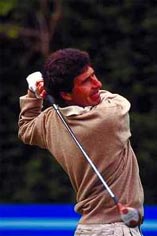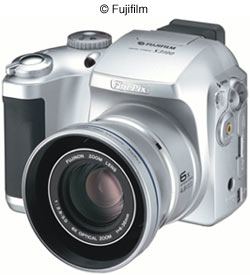
"Be the ball!"
Ah, that sage advice offered by Chevy Chase in one of our all time favorite movies, Caddyshack, should be kept in mind by photographers who hoist a camera on the links.
In a nutshell, sports photography is tough. While there are lots of great sports photos published, the average newspaper is full of mediocre sports photos nearly every day. The reason that sports photography can be tough is because it's hard to get a good photograph of action in most sports.
That's the bad news about golf photography. The worse news is that golf is one of the hardest sports to photograph. There's no physical contact between players, the course is tremendous and the ball is tiny and travels very rapidly through the air. It's hard to get a good angle to take golf photos without impairing the golfer's concentration or risking getting conked by an errant drive.
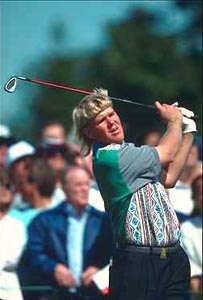
Taking good golf pictures is hard. As NYIP photography course students have learned, we say "If it's hard, that's terrific!" Because if it's hard, most people won't do it, and therefore the benefits and rewards will flow to those that do. With those words of encouragement, let's turn to the job at hand and offer some golf photo tips.
The photographs you can take on the golf course can be broken into several distinct types:
The basic action photos you see in all types of golf photography are "big swing" pictures of golfers driving off the tee or hitting long shots in the fairway; players blasting out of sand traps and other hazards; and finally, putting on the green.
Golf photography offers up lots of opportunities to photograph players reacting to their own shot or someone else's. Finally, we can take "location" portraits of golfers and record some of the scenery on the course.
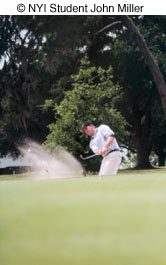
Before we look at each type of golf photo, it is essential that you remember that regardless of the kind of picture you want to make – golf photographs or any other sports photographs – following NYIP's Three Guidelines for Better Photographs will determine whether or not your photo succeeds.
As regular readers should know by now, NYIP's Three Guidelines are best recounted in the form of these simple questions you should ask yourself before pressing the shutter on your camera:
Guideline One: What is the subject of my photograph?
Guideline Two: How can I give emphasis to my subject?
Guideline Three: What can I do to simplify my photograph?
Particularly with a subject such as golf, the action of your photo is likely to be so minimal that if there are distractions they will seriously interfere with your sports photo. Look at the example below.
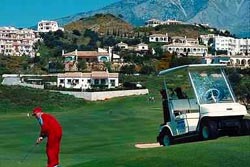
What's the subject in this golf photograph? The golfer in red? His cart? The town behind? The mountains? We could go on endlessly about the flaws in this sports photo, but we don't like to teach from negative examples. Suffice it to say everything here that isn't the subject of the photograph detracts from whatever is the intended subject. We assume it's the poorly cropped golfer in the lower left, but the other elements in the picture are certainly putting up a battle to distract the viewer.
If you are unfamiliar with NYIP's Three Guidelines we strongly suggest you look at our Picture of the Month feature. Each month we take an interesting photograph and give it a thorough analysis using NYIP's Three Guidelines. Now let's look at some good examples of the various types of golf photos.
Big Swing Golf Photos
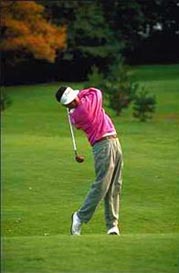
This is the bread-and-butter type of golf photograph – the golfer has completed the follow through of his swing and watches as the ball sails (hopefully) right down the fairway. We see the golfer's form, golf clothes and little else. Unlike a game played on a court or small field, in this type of sports photography, it's nearly impossible to show the player, the trajectory of the ball and the location of the green in one photo.
The lack of a visible ball is a problem. For most sports photography, the first rule is always show the ball in the photo, but that's nearly impossible to do when players are driving off the tee or making iron shots on the fairway, unless you make an image before the ball is hit.
This photo shows a more modest approach to a similar situation. Here the golf ball is visible because the player hasn't hit it yet. Instead, we captured what looks to be the beginning of the golfer's downward stroke. His golfing partner (we doubt it's a caddy) looking on from the left side of the image adds interest to the photo.
This picture makes another point as well – we suspect the photographer used a point-and-shoot camera and had intended to capture the golfer with his club poised at the top of the swing, rather than an instant later when the club head has begun its downward arc.
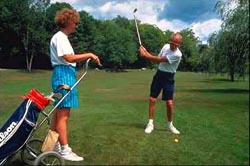
Point-and-shoot cameras have one major drawback when used for sports action photos. There is a delay of a second or two from the time the photographer presses the shutter release until the picture is actually recorded on film. That means, if you're out to capture a golf swing (or a diver in mid-air or a runner stealing home) and you wait to press the shutter until you see the peak of the action in your viewfinder, you won't get the shot you wanted.
Unlike a single lens reflex camera (SLR) where the shutter fires at the instant you push the shutter release, point-and-shoot models need a little time to set the correct focus, analyze the exposure and select the proper shutter speed and aperture. That brief delay is no problem if you're taking a photo of the kids in front of the Grand Canyon, because there is no peak moment. But for sports photography, you run the risk of missing the peak action.
There's no certain formula for overcoming this problem since all point-and-shoot camera models have a different amount of delay. So, if you use a point-and-shoot, get to know your camera and learn to anticipate peak action and press the shutter a second or two before the peak. Sports photography is one area where single lens reflex cameras have a distinct edge over point-and-shoot models, so if you're really interested in action photography, you should consider using an SLR. By the way, this "shutter lag" can be an even bigger problem with digital cameras, particularly point-and-shoot models because there is a second component called "recycle time," that is, the time needed after the image is recorded to clean that image from the capture chip into some kind of storage. It's only after the chip is cleared that the camera is capable of taking the next picture. While shutter lag in digital cameras is less of a problem than it used to be, you'll want to experiment with your camera to get a feel for how much of an issue it might be with your particular model
Sand Trap Photos
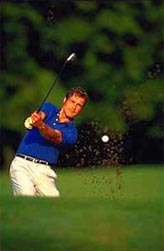
Golfers playing out of sand traps and other hazards provide for more elements of visual interest, since the golfer often blasts a club full of sand along with the ball, and the speed of the ball is slower and can be captured on film. For a golf photo like the one at the left, the photographer is using a long lens and is probably standing on the far side of the green. This means that there's little distraction for the golfer and little danger of the photographer getting hit by the ball, since the golfer is trying to loft the ball onto the green near the location of the hole.
For this photo you'll need a camera with a telephoto lens. If you have a zoom lens make sure you are zoomed in on your subject as tight as possible.
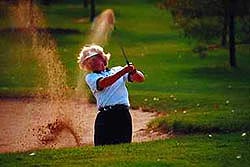
Here's a similar shot with a mountain of sand that has been churned up by the golfer. The ball appears to have vanished from the frame by the time the shutter fired. It's still an interesting golf photo, but showing the ball would have helped. Of course, no matter what type of camera you are using, in an action sport like golf, you may not know exactly what you've captured on film until you look at the processed photos. That's part of what makes sports photography interesting.
On the Green
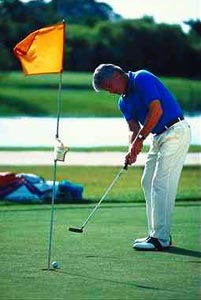
Golfers putting on the green give photographers a different range of options. Here you have a real opportunity to get reasonably close to the subject and the speed of the ball has slowed down to the point where it can be captured. Our guess is this player made this putt. We can't imagine that the ball is going to stop on the lip of the cup. The visual elements in the photo are simple – the green, the pin and hole, and the golfer. In addition, there's the background and the lighting. Try to pick your best location and settle into your spot before the golfer starts to line up the putt so you won't distract the player.
In this photo we don't mind that the photographer's face is in shadow, nor does the golf bag behind the pin bother us. It's an action photo and the course scenery behind the player adds to the story.
Reaction Shots
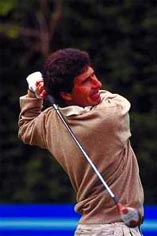
"Reaction shots" are common to all types of sports photography. In many situations and in every sport, players (or fans) reacting to the game are much easier to photograph than the action itself. That's why you see lots of reaction shots in the sports pages of your daily paper – basketball players with their arms raised, football stars high-fiving each other in the end zone, and so on. In golf, other than an occasional wave of the putter, you're likely to photograph golfers' facial reactions to their own shot or someone else's.
We don't think this guy looks too satisfied with the path of his ball. The club rests on his shoulder and a grimace unfolds across his face. Our guess – sand trap!
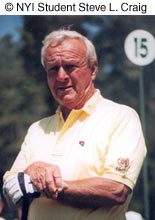
If you can get close to a famous golfer even when he's just waiting to tee up, you're in position to make a location portrait that tells a story any golfer will appreciate. Look at the concentration on Arnold Palmer's face at a Masters in Augusta a few years back, before he retired. We see the ball and tee in his right hand, club and glove on the left, and the marker for the 15th Hole in the background adds to the sense of location.
A little fill flash would give us a better view of Palmer's eyes, but we know the face so well that it doesn't matter. Note the logos of Palmer's corporate sponsors are clearly visible.
Action photos with a long enough lens can also serve as portraits, particularly if you have an angle that gives your camera a clear view of the face and even illumination.
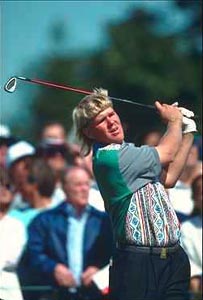
It's important to bear in mind that golf is a sport of concentration and that golfers in the midst of a competitive round should be not be distracted by a photographer getting too close or moving around when the golfer settles in to make a crucial putt. A lot of great sports photos can be made during practice rounds or when your favorite golfer is practicing on the driving range. While civility wanes in many of today's sports venues – witness the basketball fans making noise when a player from the opposing teams steps to the foul line – most golf courses remain places where the players are entitled to expect that their need for concentration will be honored.
In closing, let's consider the scenic possibilities on the golf links. Golf courses are designed to look attractive and some of them are also located in highly scenic areas. While landscapers and designers may enjoy photos of empty golf courses, we think the scenery of any course is best captured while the golf course is being used.
Scenic Golf Photos
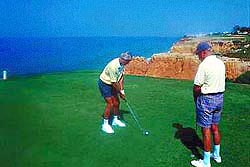
Players on a scenic golf course give a sense of scale to the image. In photos of this type, the identity and facial expressions of the players are less important than having them positioned in a way that allows you to make a photograph that shows the scenery of the golf course to its best advantage.
While it may be hard to capture that perfect golf action photo of the key shot made by the big star who won the major golf tournament, we guarantee if you follow our sports photography and golf photography advice in this article, you'll be able to take great golf photos of your friends and family next time you head out to your local course. Think of the benefits – fresh air and a camera that is much lighter to tote than a bagful of clubs. What could be more pleasant than a round of golf without having to worry about whether you break par?


